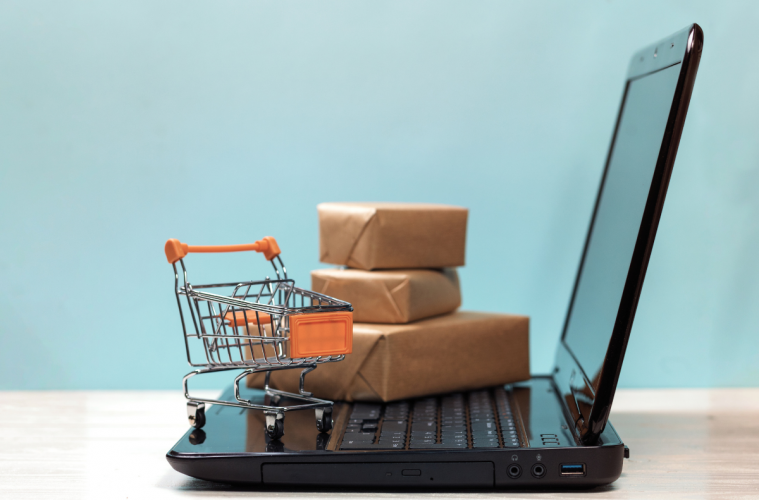E-commerce trends drive online retail sales. So, what were the most prominent trend predictions for 2021, and did they turn out to be true?
![]() Year on year, trends come and go in every industry — especially in the eCommerce space, where new products can whip up a storm overnight, or where a campaign can go viral and affect marketing plans for businesses across the board.
Year on year, trends come and go in every industry — especially in the eCommerce space, where new products can whip up a storm overnight, or where a campaign can go viral and affect marketing plans for businesses across the board.
In 2020, the Covid-19 pandemic changed the way that consumers shop completely, and the after effects are still being felt well over 12 months later. So what were the biggest predicted eCommerce trends of 2021, and did they become a reality? This article will dig into four of the biggest trends predicted for 2021.
- Sustainable trending products and pledges
- AI and AR are on the rise
- More payment options will be available
- Mobile will dominate eCommerce payments
Sustainable trending products and pledges

With rising awareness of global environmental issues, so called ‘green consumerism’ has rapidly become more popular. In recent years, numerous documentaries have driven consumer awareness, heightening the demand for eco-friendly products. Some of the films have highlighted how specific industries harm the environment, and how regulatory bodies do little to govern or control environmentally damaging business activity.
Green consumerism can be defined in two ways:
- The quest for products that have been produced in an eco-friendly manner
- Consumer preference for companies that have pledged to do their part for the environment by changing their policies or improving their products
In the run-up to 2021, many industry experts predicted that sustainable products would get increasingly popular — and that does seem to have happened. A survey from Deloitte found that 61% of consumers have demonstrated a commitment to sustainable lifestyles and have cut back on single use plastic this year, with 75% saying they wanted brands to use less packaging. Then, more than a quarter (28%) said that they had stopped purchasing from certain brands due to concerns about their sustainability practices.
A 2021 report from Accenture found 60% of consumers were making more environmentally friendly and ethical purchases since the pandemic started, and 90% intended to continue doing so long term. This shows that sustainability has become a strong influence on consumer behaviour, and that it’s likely to have an even greater effect as information and environmental data becomes more readily available.
AI and AR are on the rise
The Covid-19 pandemic made in-store shopping very difficult, if not impossible. Many businesses responded by adopting Artificial Intelligence (AI) on their websites — chatbots, for instance — to deal with customer service enquiries. Some organisations also installed recommendation algorithms designed to offer personalised guidance and products to consumers.
AI analyses information, including consumer shopping history and browsing data, to make personalised product recommendations. It’s become increasingly prevalent online in tandem with the rise of big data — and pundits suspected that 2021 would see even greater adoption of embedded AI.
Augmented reality (AR) also makes the shopping experience more intuitive — but in a slightly different way. Online shoppers cannot view or touch the item they’ll be buying, but AR bridges this gap by blending reality with virtual reality, allowing customers to ‘try’ before they buy. This can be used for many products from eyeglasses (such as Specsavers in Australia) to furniture (IKEA were early adopters).
In 2021, it looks like businesses have widely adopted AI and AR. A full 51% of ecommerce players have implemented automated technologies across their sales, marketing and customer service channels to ensure users have a seamless experience with their brand. Experts believe that this figure will grow as AI and AR become more accessible to small companies as well as large organisations.
More payment options will be available

To gain maximum sales, companies must make the checkout process as seamless as possible. If they offer several ways to pay, businesses can appeal to a variety of customers, some of whom might prefer non-traditional payment methods. Roughly 25% of consumers in a recent UPS survey said they’d abandoned their carts because their preferred payment methods were not available.
It was predicted in 2021 that more ecommerce businesses would accept digital wallets (like Google Pay, Apple Pay, as well as Paypal or Samsung) as well as the typical debit or credit card. Experts thought that Buy Now, Pay Later (BNPL) methods such as Afterpay and Zip would also become more widely used as more convenient and less immediate ways for customers to pay. Analysts also suspected that more companies would begin to accept cryptocurrencies like Bitcoin in 2021.
So did the expanded payment option trend become a reality in 2021? Overall, yes. An increased number of retail stores and ecommerce sellers added BNPL payment options to their checkout processes in response to consumer demand. In Australia, BNPL adoption by consumers is projected to grow by 24% to 2028.
While there is little data about cryptocurrency adoption so far in 2021, it’s clear that the security provided by the technology (such as blockchain) has many benefits for ecommerce sellers, and that it could grow in years to come. Now that physical stores have opened up again, it looks like brands will continue to adopt additional payment methods to make shopping a simpler experience.
Mobile will dominate eCommerce purchases
Smartphones have become the norm and apps have been developed to allow for easy shopping experiences. As a result, mobile purchases have grown exponentially year on year. In 2018, Statista estimated that by the end of 2021, mobile devices would be responsible for making 73% of total ecommerce sales.
It looks like this trend may actually become a reality when the data is reported at the end of the year. Mobile searches have become far more common, and social media has driven an increasing proportion of ecommerce sales. In fact, 55% of people who shop on their smartphones make a purchase after seeing a product on social media.
Similarly, businesses with social media presences have gained 32% more sales than those still working with traditional methods. So, while we don’t yet have the solid data to know if mobile shopping has grown since the beginning of the pandemic, it’s safe to say that mobile-friendly websites and social media purchasing are having a marked impact on customer experience.
Watch our panel of eCommerce experts from DHL, Shopify, MerchantSpring and Alibaba discuss the last 12 months of trends and what to expect in 2022.
Disclaimer:
These comments are the views and opinions of the author and should not be construed as advice. You should act using your own information and judgement. Whilst information has been obtained from and is based upon multiple sources the author believes to be reliable, we do not guarantee its accuracy and it may be incomplete or condensed. All opinions and estimates constitute the author’s own judgement as of the date of the briefing and are subject to change without notice. Please consider FX derivatives are high risk, provide volatile returns and do not guarantee profits.


